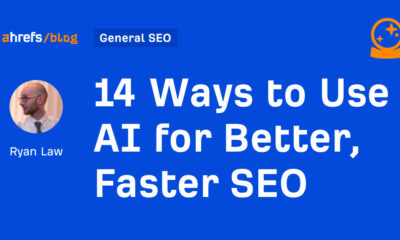MARKETING
Best SEO Strategies For Ecommerce Websites in 2023

Are you a business owner looking to build a successful ecommerce website?
If so, then SEO should be at the top of your list.
Search engine optimization can make or break an online store – optimizing for search engines is essential for any ecommerce website if you want to stand out from the competition and increase traffic.
This ultimate guide to SEO for ecommerce websites in 2023 will give you insights into how SEO works, what are the best SEO strategies for ecommerce websites, and how to create an effective SEO strategy for ecommerce websites that will help grow your business.
Let’s get started with the burning question, “What is ecommerce SEO?”
What is Ecommerce SEO, & How Does It Work?
Ecommerce SEO is the process of optimizing your online ecommerce store for search engines like Google, Bing, and Yahoo.
This means taking all the necessary steps to make your website appear higher in search results when users search for related keywords.
SEO for ecommerce site involves optimizing your website’s written and visual content, as well as its structure and technical aspects. This makes it easier for search engine robots to crawl, index, and understand your website and ultimately rank it higher in search engine results pages (SERPs).
What does “indexing” mean?
Indexing is like registering your website on Google’s directory or database.
If your website is not indexed, users won’t be able to see it, which means you can’t rank on search engines.

How Does Search Engine Optimization Work?
SEO is a combination of on-page and off-page optimization strategies.
On-Page SEO
On-page optimization involves optimizing elements on your website, such as the design, content, coding, and URL structure.
Some of the basic on-page optimization tasks include:
- Writing keyword-rich website content, titles, and meta descriptions
- Setting up an internal linking structure
- Enhancing page speed and mobile-friendliness
- Optimizing images with alt text
- Using structured data (Schema markup)
- Adding quality external links
All of these factors help search engine robots understand the purpose and content of your website so they can compare it to other ecommerce sites in organic search results.
Off-Page SEO
Off-page optimization, on the other hand, involves activities outside of your website, such as building links from other websites, using social media to promote your content, and submitting your website to directories and webmaster tools like Google Search Console.
These activities all help to increase your website’s visibility and authority in the eyes of search engines.
These on-page and off-page factors are generally known as ranking factors in technical SEO language.

But what exactly is the purpose of ecommerce SEO besides boosting search engine rankings?
Let’s have a quick rundown of the benefits of SEO for ecommerce website.
Benefits of An Ecommerce SEO Campaign
SEO for ecommerce site is essential because of the following:
1. Boost In Website Traffic & Search Visibility
One of the most obvious benefits of ecommerce SEO is that it increases the visibility of your ecommerce site and promises better engagement chances with potential customers.
Doing so builds your digital presence, drives more traffic, and increases customer conversion rates.
2. Minimize Paid Ad Costs
Investing in your ecommerce SEO campaign could mean a significant reduction in your paid advertising budget.
But, thankfully, it would still offer a higher ROI.
Why? and HOW?
Because “53.3% of all organic traffic comes from organic search.” (Source = Ahrefs)
This means more than half of the users ignore paid ads and click on organic search results.
So, cut your paid marketing costs, and double down your investment in SEO tools.
3. Enhance Brand Image
Customers are likely to trust and buy from top stores on search engine results pages simply because they are seen more often.
4. Sit Above Your Competition (Literally)
Ranking higher in search engine results not only puts you above competitor ecommerce sites on Google, but it also gives you the edge when it comes to capturing leads.
The higher your website appears in the SERPs, the more likely customers are to click through to it and make a purchase.
5. Improve Your Retargeting Campaigns
Retargeting campaigns involve targeting previous website visitors with personalized ads in order to remind them about your products and win back potential customers.
SEO can help you with this by providing you with data that lets you know how many people are visiting your website and which pages they’re viewing.
This data will allow you to better determine the right retargeting campaigns and optimize them for maximum ROI.
6. Better Usability & Customer Experience
Good ecommerce SEO practices mean that your website is optimized for usability, which in turn enhances the customer experience and makes it easier for visitors to find what they’re looking for.
This can lead to more satisfied customers and higher conversion rates, making SEO a great investment.

All in all, ecommerce SEO is one of the smartest investments you can make for your online store. It doesn’t just help you to rank higher in search engine results; it also helps you grow in every aspect and emerge as a trusted brand.
Now that we’ve covered the working and benefits of ecommerce SEO, it’s time to dive into the ecommerce SEO best practices you should be using.
12-Step Proven & Effective Ecommerce SEO Strategy (+1 Bonus Step)
Here is what a comprehensive ecommerce SEO strategy should include:
1. Registering Your Ecommerce Site On Search Engines
The very first step to kick off your ecommerce SEO campaign is to submit your website on Google, Bing, and other search engines.
Why?
Registering your website with search engines will ensure that your website is visible to search engine spiders and crawled more frequently.
Moreover, it will send you notifications about any technical issues related to crawling or website usability in general.
How to register your website with search engines?
By adding your website’s URL to the respective search engine’s webmaster tools.
For Google, it’s Google Search Console, and for Bing, it’s Bing Webmaster Tools.
2. Setting Up & Optimizing Your Website Structure
Optimizing your site architecture is one of the key ecommerce SEO tools to benefit from. A well-organized and structured website tells search engines that your ecommerce site is easy to crawl and index.

Moreover, a well-structured website appeals to customers and helps them find the information they are looking for quickly and easily.
So, you need to optimize your website structure for both.
How to optimize ecommerce site architecture for search engine bots?
It’s easy. Simply add your sitemap file to Google and Bing using the respective webmaster tools.
A sitemap is basically a visual representation of all the pages on your website that you want search engines to crawl. This should essentially include all of your product pages, category pages, blog posts, and other content.
What does a sitemap do?
It helps search engine bots crawl and index all the pages of your website. Plus, it also helps users see how your website is organized and where they can easily find the information they’re looking for.
You can create a sitemap yourself or take advantage of automated solutions such as Google’s Webmaster Tools. XML and HTML are both used for sitemaps, but HTML sitemaps are a user-friendly option.
How to optimize ecommerce site architecture for website visitors?
Besides adding a sitemap, make sure that all major pages of your ecommerce store aren’t far away from the homepage.
Users like it when a product or category page is easily accessible within three clicks from the home page, as this lets them navigate your website easily.
So, have a clear navigation system with well-defined categories and properly labeled product pages. But avoid adding unnecessary layers of pages; it could make customers feel lost.

Also, add an easy-to-spot search bar somewhere on the page (preferably in the header area). This will allow customers to quickly search and find what they’re looking for on your website.
Bonus Tip: Want to build more trust with your visitors?
Add an About Us and a Contact Us page so customers know who you are as a brand and where they can reach you.
3. Performing In-Depth Keyword Research
The next step to setting up an effective ecommerce SEO strategy is keyword research.
Why?
Because keywords are the foundation of any successful search engine optimization campaign.
They help you understand what people are searching for when they look up something related to your business and the products you offer.
So, how do you find keywords?
Two of the most effective methods are:
Use a Keyword Research tool:
There are plenty of free and paid keyword research tools available online. Ubersuggest, Answer the Public, and Ahrefs Keywords Explorer are some of the popular ones.
These tools will provide you with a list of keyword suggestions related to your business and products, their search volumes, CPCs, keyword difficulty scores, and more.
Or, you can use a free tool like Google Keyword Planner. It’s a great way to find relevant and popular keywords for your website.
Bonus Tip: You can use the auto suggest feature on Amazon, Etsy, and other platforms to find more relevant keywords.
Google’s Autosuggest:
Another easy way to find keyword ideas is through Google’s auto suggest feature. All you have to do is type a keyword into the search box, and Google will automatically suggest related terms.
For example, if you type ‘running shoes,’ it’ll give you a list of related keywords such as ‘best running shoes,’ ‘running shoes for women,’ and so on.
These keyword suggestions will give you a better idea of what people are searching for, allowing you to create targeted content and campaigns.
Plus, you’ll uncover excellent long-tail keywords with high buying intent — which brings us to another aspect of ecommerce keyword research.
4. Understanding Search Intent & Creating Relevant Content
Search intent refers to the intention behind search queries: the reason why people are searching or looking up a particular keyword.
Identifying search intent and optimizing your content accordingly is the key to driving more organic traffic and conversions.

For example, if someone is searching for ‘running shoes,’ their search intent could be learning about features, pricing, and different options available in the market.
You can optimize your content around this intent and write product-review articles, comparison articles, or guides, including informational keywords.
On the other hand, if someone’s searching for “running shoes for men under $200,” it means they’re almost ready to spend that amount. You can create website pages targeting those keywords and include relevant calls-to-action in your product pages, category pages, and product descriptions.
The key is to understand what people are searching for and create content that aligns with the search intent. This will surely help improve your SEO rankings.
5. Optimizing Your Website
Once you’ve done your keyword research and identified search intent, the next step is to optimize your existing website content.
Add Keywords
Include your keywords in the following:
- Title tags, meta tags, and meta descriptions on your home page, ecommerce category pages, product pages, and blog posts.
Why?
Because users see these tags and descriptions first when they search for a keyword on Google, so it’s important to make sure they are optimized.

However, you would want to stay away from keyword stuffing and place them naturally throughout your content.
Write descriptive URLs including your primary keyword, to get an edge over your competitors.
Having keywords in the URL helps you stand out in the eyes of both the search engine and visitors.
This is the text you add to images to serve as an alternative text for search engines. This gives Google the ability to read what your image is about, giving you an extra boost in rankings.
Tip: Adding modifiers such as “Coupon,” “Discount,” and “Free Shipping” in your meta description can increase clickthrough rate (or CTR), which is a strong ranking factor in the eyes of Google.
Focus On Link Building
Link building is an indirect ranking factor, but it can make a huge difference in your SEO rankings. There are two sides to it:
Internal links – Link to other pages on your website. This helps Google better understand the structure and content of your website, which can help boost rankings. Moreover, it also helps visitors stay on your site for longer.
External links – Link to other relevant websites and blogs. This helps Google verify that your content is valuable and trustworthy, thus boosting rankings.
But make sure you only link to relevant and credible websites and don’t link to irrelevant or low-quality sources. Not only is it bad for SEO, but it also ruins user experience and reflects poorly on your reputation.

Also, try not to link to direct competitors, as it will give them free traffic and a possible ranking boost to outrank your website.
6. Creating High-Quality Backlinks To Your Ecommerce Website
Backlinks are one of the most powerful ranking signals for Google and an excellent way to strengthen your SEO strategy for ecommerce website. The more high-quality backlinks you have, the higher your website will rank in search engine results pages (SERPs).
You can get high-quality backlinks from authority websites in your niche. Consider guest blogging, directory submissions, and leveraging social media to get some relevant backlinks. You can also reach out to influencers in your niche to get them to link to your website or products.
Lastly, make sure the backlinks are from credible sites and use relevant anchor text to increase the chances of getting a higher ranking.
7. Enhancing User Experience
Google uses a number of factors to determine the quality and relevance of content, one of which is user experience. It looks at how long users stay on a page and whether or not they find the information useful.
A good user experience is essential for ecommerce SEO success, so make sure your website is easy to use, and navigation is simple.
Here are a couple of things you can do to improve user experience.
Have a Responsive Design:
Make sure your website is optimized for mobile devices and has a responsive design. This will ensure that users on all types of devices have a good experience navigating your website.
Reduce Page Load Speed:
Page load speed is one of the most important factors for user experience and SEO. If your website takes too long to load, users will quickly leave, and it will hurt your rankings.
Make sure the page is optimized for speed by using caching, compressing images, and minimizing scripts.
Add a Search Bar:
Adding a search bar to your website makes it easier for users to find what they’re looking for. This helps reduce bounce rate and keeps users on your website for longer.
Create User-Friendly Checkout:
The checkout process should be simple and straightforward. Make sure the checkout process is easy to navigate and keep distractions to a minimum.
Also, provide features like guest checkout and payment options such as PayPal and credit card to ensure customers have a smooth checkout experience.
Following these tips will help you make your ecommerce website more user-friendly and help visitors stay long enough to convert into paying customers. It will, in turn, signal Google to rank you higher than websites with poor design and high bounce rates.
8. Having An Optimized, Simple URL Structure
Having a simple URL structure is super important from an SEO perspective. Why?
Because it simplifies navigation for users and helps search engine crawlers understand the structure of your website more easily.

Here are a few URL tips to keep in mind:
Your URL should be short. 50 to 60 characters is the recommended limit.
- It should be easy to read and understand.
- Include your target keyword in the URL.
- Don’t use stop words in URLs, such as “the,” “and,” “of,” and “a.” This will help keep your URL short.
- Also, make sure you use hyphens (-) to separate words instead of underscores (_).
For example, a bad URL structure would look like this:
https://www.mystore.com/blog_about_mens-shoes/
On the other hand, a simple URL structure would be:
https://www.mystore.com/shoes-mens-shoes-articles/
9. Using Schema Markups To Facilitate Google And Users
Schema markup is a type of structured data that helps search engines understand the content on your website. It’s basically a code added to your HTML that provides additional information about what’s on the page.
Using schema markup can help search engines display your website’s information in the form of rich snippets, like product markup snippets and review snippets. These snippets help users spot useful information faster and easier.
The most common ecommerce schema are:
- Product schema: For displaying product-related information like price, availability, and images. This extension also allows more efficient displaying of product ads.
- Review schema: For displaying review ratings and summaries on the search result page. Users can see the reviewer’s information and verify if the review is credible.
- Video schema: For displaying videos in search results. This extension helps search engines understand the type of video and its content.
- Price schema: For displaying pricing information of products. It is often used to display price ranges for product variations.
Using schema markups will help you get more visibility and clicks from search results, which eventually leads to better SEO rankings (and more sales).
10. Tackling Duplicate Content
Duplicate content is when one page has the same or similar content as another page, which is a common issue for ecommerce stores.
Having duplicate content on your website is bad for SEO because it creates confusion for search engines and makes it difficult to determine which page should be ranked higher in search engine results pages.
You can avoid this by using canonical tags. These tags essentially tell search engines which page is the original or “master version” and that all other pages with similar content are to be ignored.
Or, you can use the Robots.txt file to block duplicate content from being indexed.
Both methods work, but the canonical tag is preferable since it offers more control over duplicate content.

By avoiding duplicate content, you will be able to improve your SEO for ecommerce site and get better SEO rankings.
11. Monitoring & Tracking Your Ecommerce SEO Efforts
Finally, you should monitor and track your ecommerce SEO efforts to measure their effectiveness.
How?
Google Analytics is one of the best ecommerce SEO tools out there, and it can be used to track your website’s performance. By setting up goals and tracking metrics like bounce rate, time on page, and click-through rate (CTR), you can get insights into how well your SEO efforts are working.
You can also use other tools like Screaming Frog, DeepCrawl, and Ahrefs to audit your website and track changes in the backlinks.
You should also use A/B testing to determine which changes have a positive impact on your SEO rankings.
By tracking your ecommerce SEO efforts, you will be able to identify areas where you need improvement and make the necessary changes. This will help you achieve better SEO rankings and more organic traffic in the long run.
12. Keeping Up With SEO Trends
SEO trends are constantly changing, and you need to stay up-to-date if you want to keep up with the competition.
You can do this by attending SEO conferences, reading industry blogs, and staying up-to-date with the latest Google updates.
You should also keep an eye on your competitors’ SEO strategies and use tools like Ahrefs to monitor changes in their backlinks.
By keeping up with SEO trends, you’ll be able to create effective SEO strategies for ecommerce websites, stay one step ahead of the competition, and stay on top of the SERPs.
And now for some more value, here is a BONUS that most ecommerce brands ignore.
13. BONUS = Leveraging The Power Of Pinterest SEO
Did you know that Pinterest is a search engine in itself?
People search on Pinterest just like they would on Google or Bing.
However, instead of delivering traditional results like Google, it offers visuals.
So, when someone enters a query in the Pinterest search bar, it will work to find the most appropriate (read: optimized) pins for that individual’s needs.
This means with a proper Pinterest SEO strategy, you can increase your profile’s visibility and get more website traffic from this unique search engine.
Here are a few actionable tips to optimize for Pinterest SEO:
- Get a Pinterest business account, as it has more optimization features.
- Use relevant keywords in the pin description and post titles.
- Create visually appealing pins optimized for Pinterest.
- Include links to your website in the pin description.
- Incorporate rich pins into your strategy.
- Optimize the board titles and descriptions for keywords related to the content you are sharing.
- Use keyword-rich headlines on your blog posts and link them to corresponding Pinterest boards.
Follow these simple tips to improve your SEO for ecommerce website, drive more traffic, and increase your overall visibility online.
Build Your Way To Success With Ecommerce SEO
Following the above-listed strategies will surely help you build a successful ecommerce website that ranks well and drives more sales.
But remember, ecommerce SEO is an ever-evolving field, and staying up to date with the latest trends can be a challenge.
This is where an Ecommerce Marketing Mastery Certificate can help – it will equip you with the most up-to-date knowledge and competencies to make your ecommerce business succeed.
Or consider having an expert team that understands SEO strategies for ecommerce by your side to implement the latest tricks of the trade.
No matter which way you decide to go, your ecommerce business will surely benefit from the power of SEO.
MARKETING
3 Contextual Link-Building Strategies That Actually Work

Quality content can get your web pages ranking higher in Google search results. But contextual links can help, too.
Google says the inclusion of relevant, high-quality links signals the content that includes them may be quality content, too.
So, how can you earn contextual links to give your content an edge over the competition? Adopt one, two, or all three of the strategies detailed in this article.
But first, let’s understand what contextual links are.
What are contextual links?
A contextual link appears in the body of a web page’s content. A hyperlink is added to a relevant word or phrase. They:
- Link to other pages on the site.
- Cite the source of a claim or statistic.
- Indicate other relevant pages.
- Provide readers with more in-depth information on the topic.
- Guide readers to a product or service.
In this screenshot of an article with the header, Challenges of Productivity Tracking in Remote Workplaces, three phrases are hyperlinked — measure productivity, Microsoft, and research by Gartner.
Each contextual link serves a purpose:
- “Measure productivity” goes to a Slack article about how to measure employee productivity.
- “Microsoft” directs the reader to the original research for the cited statistic.
- “Research by Gartner” links to the native source for the research cited in that paragraph.
With a contextual link-building strategy, you not only boost your content in the eyes of Google but also encourage other sites to use your valuable content to provide their readers with additional information or context.
Now, let me show you three strategies to grow your contextual links and improve your content’s rankings.
1. Help sites fix their broken links
Broken link building involves contacting a website, pointing out a broken external link on a page, and suggesting your content as its replacement.
Broken links could result from a 404 error, a blank page, or a redirect to an irrelevant page — any alteration that ruins the original link’s purpose.
Since broken links negatively affect the visitor experience, removing them is in the site’s best interest. Your replacement offer gives them a quick solution to their problem. Plus, people are more willing to help you after you’ve helped them.
To find broken links, use a tool like Free Backlink Checker extension. I also like to inspect links manually since most tools only pick up 404 errors. Rely solely on them, and you will miss relevant broken-link opportunities.
Ahrefs also has tools for finding broken links. Its free broken link checker is helpful, but the paid version is more robust.
Paid subscribers can go to Site Explorer, go to the Outgoing Links report, and click on “Broken Links” from the dropdown menu.
The report identifies the total number of broken links (3,136 in the example below), the referring pages (the URL for the content including the broken link), the anchor (the words hyperlinked in the content), and the link (the URL that no longer directs to a viable page).
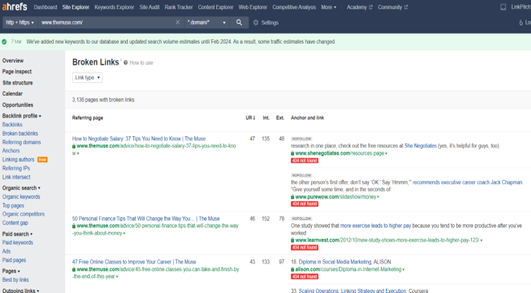
Ahrefs subscribers can also compile a Best by Links report under the Pages option in the Site Explorer tool.
In this example, the report lists pages with 404 page-not-found errors for TheMuse.com. It has 6,230 pages with broken external links. Each page URL listed is accompanied by the number of referring domains and a number of links to the page.
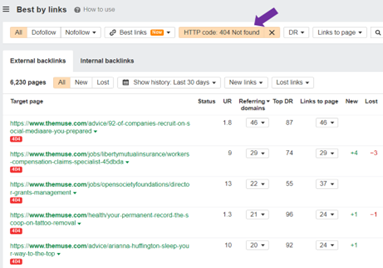
This research can identify the topics with the biggest potential to become the fixes for a broken link. You can create content to address them or identify content you already published. Just make sure the content closely matches the intent of the anchor text’s original link.
For example, the same research report, which is now a broken link, is cited in articles from Oyster and TINYpulse. On Oyster, the anchor text reads, “44% of companies did not allow remote work.” On TINYpulse, the anchor text says, “only 33% are very satisfied with the level of trust in their organization.”
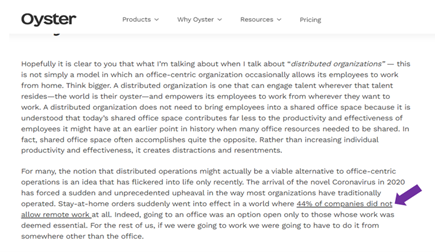
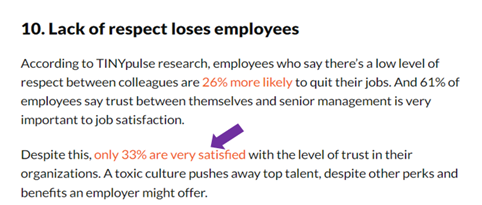
For a single article link to replace the broken link on Oyster and TINYpulse, the content would need to cite both a statistic about remote work and another stat about trust in organizations.
2. Guest posting
Like the broken-link replacement strategy, guest posting benefits both your and the recipient’s sites. You reach out to sites and offer to write content about a topic relevant to their audience that relates to your content subjects and includes a link to your site. This technique works well because you typically control where and how to add your link to make it as relevant as possible.
You can take multiple approaches to win guest-posting opportunities. No matter which tactics you use, track the sites and verify the site’s quality using Ahrefs, another tool, or a direct visit to the site.
First, you can use Ahrefs (or a similar tool) to examine your competitors’ backlinks and identify any links that come from guest posts. The anchor or surrounding text might hint at its status with phrases such as “contributed by,” “guest post by,” or the name of the brand or author. You also can check links manually to see if they’re contributed content.
In this example from Collegiate Parent, the headline reads “EFC Too High? Tips for Successful Aid Appeals” and includes a byline for “Billie Jo Weis.” At this point, you don’t know if it is a contributed article.

But scroll down to the end, and you can see the author’s bio. It confirms the article is a guest post because her bio says she is a client services advisor for My College Planning Team, not the publisher (Collegiate Parent).

You can also use Google search operators to identify sites open to guest contributions. You’ll want to do several searches using variations of your target keywords and topic accompanied by phrases, such as “guest post,” “contributed by,” “guest post by,” and “guest posting guidelines.”
The example in the screenshot below works for a brand targeting college prep topics. The search is “’college prep’ ‘guest post by’ -site.pinterest.com.” The results reveal four articles from four sites that use the words “college prep” and “guest post by.” You can add those sites to your outreach tracker.

Finally, you can list sites relevant to your niche that didn’t appear in the earlier searches.
TIP: Not all sites that accept guest articles say so on their website.
3. Niche edits
A niche edit, sometimes referred to as a link insert, is a technique that adds a link to existing content. The key to success is finding relevant articles on high-quality sites and pitching your content as a valuable addition to those articles.
You can use a similar process to the Google guest post search. Input a broad keyword for your targeted keyword, then tell it you don’t want the targeted keyword in the title. If the entire article is about your targeted keyword, your chances of getting the publisher to include a link to a similar article are low.
Here’s an example from one of our client’s that sought to make niche edits for the keyword “soft skills.”
The Google search included these phrases:
- “Organizational development” soft skills -intitle:”soft skills”
- “Organizational development” soft skills employee training -intitle:”soft skills”
- Soft skills employee training -intitle:”soft skills” organizations
It led to an added link for “soft skills” in this article — “Employee Development,” which includes the header, “What are the benefits of employee development for an organization?”
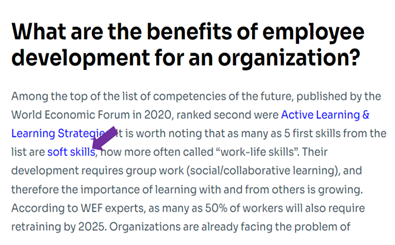
You can do several searches, modifying your search operators each time to see what sites and content appears. Think of multiple angles to broaden the potential sites that publish content with your targeted or a related keyword.
After you’ve crafted a list of high-quality prospects, it’s time for outreach.
Niche edits might be the hardest of the three strategies to achieve because they’re not as clear of a win-win situation as the other two (repairing broken links and publishing new content).
Your email pitch can make or break your niche-edit campaign. It must convince the publisher that your content provides so much value that they will want to take an extra step with content they’ve already completed.
Here are some tips to craft a link-earning email pitch:
- Start by mentioning something about them. It could be something you like about their website or the article you’re targeting. You want them to know you’ve explored their site and read the article. But don’t overdo it. A simple compliment or sentence about how you found the article helpful should suffice.
- Introduce your content and mention how it can help their audience. Be concise and convincing, but don’t oversell it.
- Go one step further and point to a section or sentence where you think your content might be a good fit. This will help them see where your content can add value and link to it.
Get linking
Though contextual link building may seem challenging to execute, it can bring great rewards. Follow these tips and strategies, and your valuable content will get more attention from external sites and eventually Google rankings where it deserves to be.
All tools mentioned in this article are identified by the author. If you have a tool to suggest, please tag CMI on social.
HANDPICKED RELATED CONTENT:
Cover image by Joseph Kalinowski/Content Marketing Institute
MARKETING
Google’s Surgical Strike on Reputation Abuse
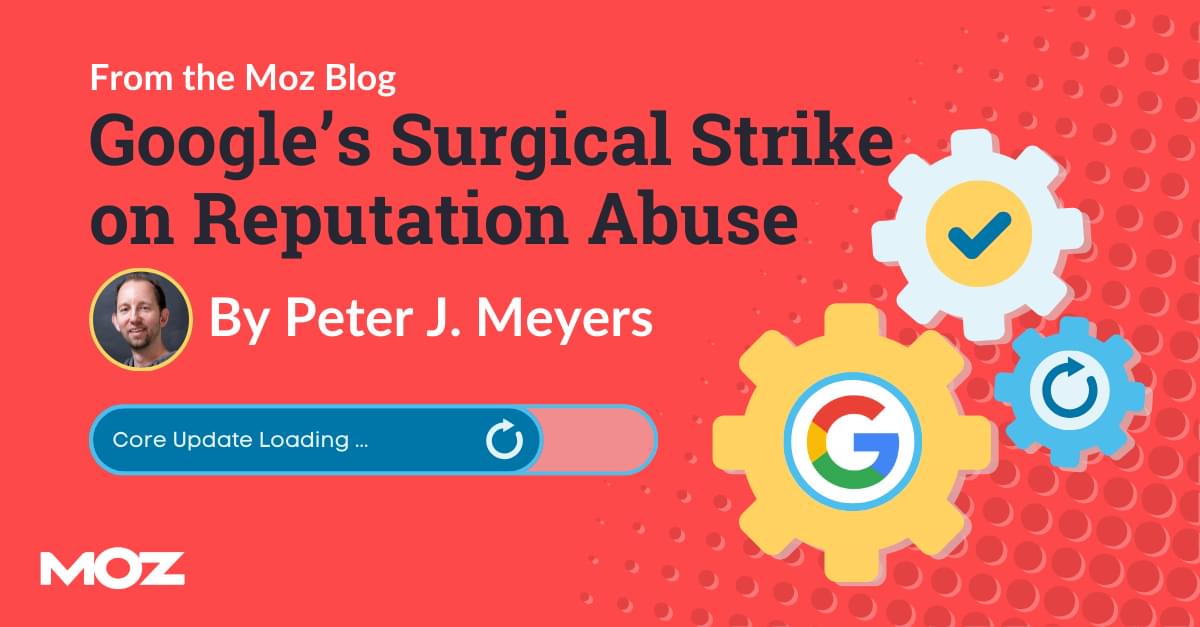
These aren’t easy questions. On the one hand, many of these sites do clearly fit Google’s warning and were using their authority and reputation to rank content that is low-relevance to the main site and its visitors. With any punitive action, though, the problem is that the sites ranking below the penalized sites may not be of any higher quality. Is USA Today’s coupon section less useful than the dedicated coupon sites that will take its place from the perspective of searchers? Probably not, especially since the data comes from similar sources.
There is a legitimate question of trust here — searchers are more likely to trust this content if it’s attached to a major brand. If a site is hosting third-party content, such as a coupon marketplace, then they’re essentially lending their brand and credibility to content that they haven’t vetted. This could be seen as an abuse of trust.
In Google’s eyes, I suspect the problem is that this tactic has just spread too far, and they couldn’t continue to ignore it. Unfortunately for the sites that were hit, the penalties were severe and wiped out impacted content. Regardless of how we feel about the outcome, this was not an empty threat, and SEOs need to take Google’s new guidelines seriously.
MARKETING
18 Events and Conferences for Black Entrepreneurs in 2024

Welcome to Breaking the Blueprint — a blog series that dives into the unique business challenges and opportunities of underrepresented business owners and entrepreneurs. Learn how they’ve grown or scaled their businesses, explored entrepreneurial ventures within their companies, or created side hustles, and how their stories can inspire and inform your own success.
It can feel isolating if you’re the only one in the room who looks like you.
-

 MARKETING3 days ago
MARKETING3 days ago18 Events and Conferences for Black Entrepreneurs in 2024
-

 MARKETING5 days ago
MARKETING5 days agoAdvertising on Hulu: Ad Formats, Examples & Tips
-
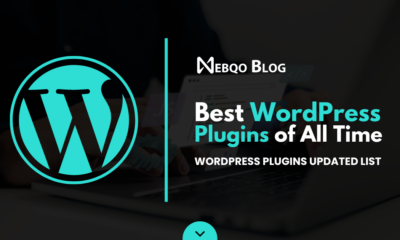
 WORDPRESS6 days ago
WORDPRESS6 days agoBest WordPress Plugins of All Time: Updated List for 2024
-

 MARKETING6 days ago
MARKETING6 days agoUpdates to data build service for better developer experiences
-

 WORDPRESS6 days ago
WORDPRESS6 days agoShopify Could Be Undervalued Based On A Long-Term Horizon
-

 PPC6 days ago
PPC6 days agoLow Risk, High Reward YouTube Ads alexking
-

 PPC7 days ago
PPC7 days agoGoogle Shopping: A Beginner’s Guide to Crafting a Compelling Campaign Google Shopping: A Beginner’s Guide to Crafting a Compelling Campaign
-

 WORDPRESS4 days ago
WORDPRESS4 days ago5 Must See Telegram Plugins for WooCommerce



